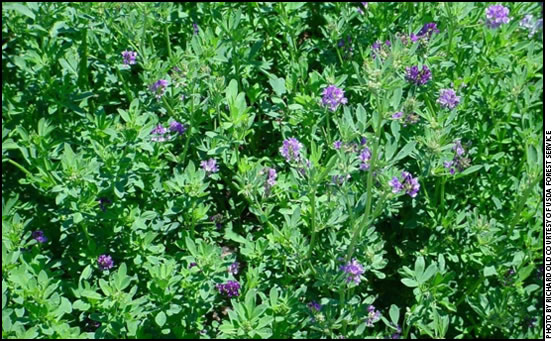Tips for Grazing Alfalfa
Properly managed, alfalfa can provide a summer grazing resource.
Alfalfa is considered the most important forage legume grown in the U.S. It's adapted to a wide variety of soil and climatic conditions and offers potential for both high quality and high yield. Many producers cut alfalfa for hay or silage, but relatively few consider letting their cattle do the harvesting. Perhaps the most common reason is fear of bloat (gas trapped in the rumen), which may be associated with grazing of legumes.

However, alfalfa can be a valuable summer grazing resource for cow-calf and stocker operations. It can complement other range and pasture resources and add flexibility to grazing systems. And, under proper management, cattle perform well on alfalfa. Alfalfa grazing studies by the Oklahoma-based Noble Foundation showed stocker cattle can gain an average of 2 pounds (lb.) per head per day, with total gains of 320-420 lb. per acre per year.
For the last 15 years, Wausa, Neb., grazier Brad Young has applied management-intensive grazing to his cattle operation. Young's forage base has included native and improved grass pasture, summer annuals, turnips and legumes. He uses alfalfa for hay, too, but calls it a ready grazing resource to bridge gaps between availability of other forages and to extend the grazing season. Thus far, he's never lost an animal to bloat.
"I tell other producers to be aware of the risk, but don't be afraid of bloat," Young says. "You can manage the risk."
Young recommends planting an alfalfa-grass mixture to help minimize the danger. Or, grasses could be interseeded in existing alfalfa stands. Young also advocates planned rotational grazing. A series of grazing paddocks should be grazed in succession, for a relatively short period of time, followed by a period of rest and regrowth. When implementing the plan, Young's first rule is to never introduce hungry cattle to a new paddock.
"Have them full of dry grass or hay before you turn them in, so they don't load up," Young warns.
"When grazing straight alfalfa, it's best for the cattle to always have access to dry hay," he notes. "It doesn't have to be top-quality, as long as it's palatable. Wheat or oat straw can work. Even if they eat only a few pounds of hay per day, that's usually enough to prevent bloat. Or, you can shut them up with the hay for part of each day, to make sure they eat it."
Young cautions against turning cattle onto alfalfa that is wet with dew. Afternoon, rather than morning, is usually a better time to move cattle. Potential for bloat is also higher during cool, cloudy, rainy conditions. Bloat risk is greater when alfalfa is immature. Risk is also high immediately following a killing frost.
Varieties of alfalfa have been developed to be more tolerant of grazing conditions than "hay-type" varieties. Some varieties are claimed to present low bloat potential. Young, who is also in the seed business, suggests producers take such claims with a grain of salt.
"There's no guarantee," he states. "It's still best to manage grazing to minimize the risk."





